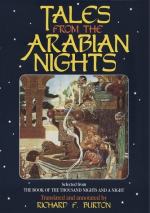Note On The History of Habib
The older translators of this “New Arabian Night” have made wild work with this Novel at least as the original is given by my text and the edition of Gauttier (vii, 60-90): in their desire to gallicise it they have invested it with a toilette purely European and in the worst possible style. Amongst the insipid details are the division of the Crystalline Islands into the White, Yellow, Green and Blue; with the Genies Abarikaff, the monstrous Racachik, Ilbaccaras and Mokilras; and the terrible journey of Habib to Mount Kaf with his absurd reflections: even the “Roc” cannot come to his aid without “a damask cushion suspended between its feet by silken cords” for the greater comfort of the “Arabian Knight.” The Treasury of Solomon, “who fixed the principles of knowledge by 366 hieroglyphics (sic) each of which required a day’s application from even the ablest understanding, before its mysterious sense could be understood,” is spun out as if the episode were copy intended for the daily press. In my text the “Maidens of the Main” are introduced to say a few words and speed the action. In the French version Ilzaide the elder becomes a “leading lady,” whose role is that of the naive ingenue, famous for “smartness” and “vivacty”: “one cannot refrain from smiling at the lively sallies of her good nature and simplicity of heart.” I find this young person the model of a pert, pretty, prattling little French soubrette who, moreover, makes open love to “the master.” Habib calls the “good old lady,” his governess “Esek! Esek!” which in Turk. means donkey, ass. I need hardly enlarge upon these ineptitudes; those who wish to pursue the subject have only to compare the two versions.
At the end of the Frenchified tale we find a note entitled:—Observations by the French Editor, on the “History of Habib and Dorathil-goase, or the Arabian Knight,” and these are founded not upon the Oriental text but upon the Occidental perversion. It is described “from a moral plane rather as a poem than a simple tale,” and it must be regarded as “a Romance of Chivalry which unites the two chief characteristics of works of that sort,—amusement and instruction.” Habib’s education is compared with that of Telemachus, and his being inured to fatigue is according to the




